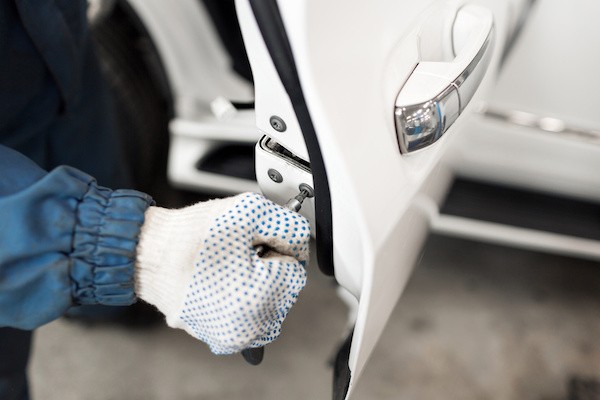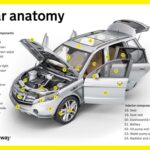If you’ve ever considered the intricate engineering of your vehicle, you’ll realize it’s more than just a frame and engine. Thousands of components work in harmony to ensure its functionality and safety. Among these, the seemingly simple car door mechanism is a marvel of engineering, relying on a network of parts to operate smoothly. When something goes wrong with these parts, particularly the Car Door Mechanism Parts, daily tasks like entering or exiting your vehicle can become frustrating. A common culprit in door malfunctions is often related to the latch system and its associated components.
Car door mechanisms are diverse, varying across vehicle models and door designs. However, the fundamental principle remains consistent: to securely fasten the door to the car frame while allowing for easy opening and closing. These mechanisms utilize various components, from spring-loaded systems to specialized seals, each playing a critical role. Understanding these car door mechanism parts is crucial for any car owner, offering insights into maintenance and potential repairs. Let’s delve into the essentials.
Understanding the Core: What are Car Door Mechanism Parts?
The car door mechanism is a complex assembly that allows your car door to function correctly. It’s not just one piece, but a collection of car door mechanism parts working in unison. The most prominent of these is the door latch, a critical component responsible for holding the door closed and allowing it to open when needed. Typically located within the door and aligning with the car’s body frame, the latch interacts with other parts to ensure secure closure and release. While many latches are constructed from durable plastics, high-end vehicles often feature metal latches for enhanced longevity and robustness. Nearly every vehicle, with few exceptions, incorporates a latch system as part of its door mechanism.
How a Car Door Operates: An Overview of the Mechanism
While a car door appears straightforward, its operation is underpinned by a sophisticated interplay of car door mechanism parts. Beyond the outer panel, a car door integrates numerous mechanical elements designed for seamless opening and closing. Some doors even include additional features like integrated speakers and wiring for power windows and locks.
A standard car door mechanism comprises several key car door mechanism parts:
- Door Handles: The interface for opening the door from both inside and outside the vehicle.
- Door Hinges: Allow the door to pivot open and closed, attaching the door to the car body.
- Door Latches: Secure the door closed and release it for opening.
- Door Anchors (Strikers): Mounted on the car frame, they receive the latch to hold the door shut.
- Door Locks: Provide security, preventing unauthorized entry.
- Linkages and Rods: Connect handles and locks to the latch mechanism.
- Actuators (for power locks): Electrically operate the locking mechanism.
Among these car door mechanism parts, the latch system is paramount. Latches function as specialized clamps that engage with the striker to keep the door shut while the car is moving. When these car door mechanism parts fail due to wear or damage, you might encounter difficulties with your door sticking closed or failing to close properly, compromising both vehicle security and passenger safety.
 Car door and details of mechanism parts
Car door and details of mechanism parts
A Closer Look at the Latching Mechanism and its Parts
The design of car door mechanism parts, particularly latches, has undergone significant advancements. Modern latch mechanisms are engineered not only to firmly secure the door against the door jamb during normal driving conditions but also to allow door opening in emergency situations, such as after a collision.
The intricate latching mechanism itself involves several smaller car door mechanism parts, typically including:
- Latch Bolt (Claw/Fork): The primary component that physically engages with the striker.
- Detent Lever: A spring-loaded lever that holds the latch in the closed position.
- Release Lever: Connected to the door handle, actuates the latch to open.
- Springs: Provide tension and return mechanisms for smooth operation.
- Linkages and Rods: Connect the external handle and internal locking mechanisms to the latch.
Operationally, when you activate the door handle, either from inside or outside the car, it manipulates the release lever. This lever action, in turn, retracts the latch bolt from the striker, disengaging the door from the frame. This sequence allows you to open the door. The same principle applies to electronic systems, where switches and actuators perform the mechanical pulling of levers, often found in cars with remote-operated doors or power locks.
Troubleshooting Issues with Car Door Mechanism Parts
Experiencing difficulty in opening or closing your car door often signals a problem within the car door mechanism parts. Before seeking professional help, there are a few preliminary checks you can perform, ideally in a safe environment like your garage.
Begin by carefully inspecting the door latch and surrounding car door mechanism parts for any visible damage or obstructions. If the door refuses to close securely, it often indicates that the latch is jammed in an open or partially engaged position.
If you suspect a stuck latch, you can attempt manual manipulation to reset it. Locate the small gap on the door edge where the latch is positioned. Using a slim tool, such as a straightened coat hanger wire or a key, carefully insert it into the gap. Try to maneuver the tool upwards to gently encourage the latch to reset. While doing this, simultaneously try pulling the door handle. You might need to repeat this process several times to successfully reset the latch.
If the door is stuck in a closed position, and you’re unable to open it using standard methods like the interior lock switch, key fob remote, or manual key, avoid forcing it. At this stage, it’s advisable to seek professional assistance.
Dealing with malfunctioning car door mechanism parts, especially latches, can be complex. These systems are finely tuned, and improper handling can lead to further damage. Consulting a qualified mechanic is often the best approach to resolve these issues efficiently and prevent more significant problems. Professional expertise ensures correct diagnosis and repair, maintaining the integrity of your car door mechanism.
Final Thoughts on Car Door Mechanism Parts
While often overlooked, the car door mechanism parts are fundamental to your vehicle’s security and your daily convenience. Any difficulty in operating your car door is a clear indicator of potential issues within this system. Promptly addressing these problems is essential. Regular inspection and timely maintenance of your car door mechanism parts can prevent minor issues from escalating into major repairs, ensuring smooth, reliable door operation and contributing to the overall safety and functionality of your vehicle.
